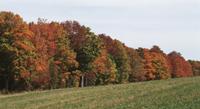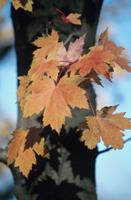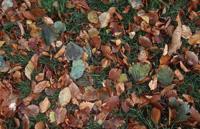Autumn color of the leaves according to the earth

It is clear why they lose the green color: the tree recovers as much as possible from the leaves before they fall to the ground, among other things, the chlorophyll that gives green color to the leaves. While on the leaf, chlorophyll participates in photosynthesis, but once absorbed from the leaves, the tree recycles its components and turns them into winter food for the rest of the tree. And if they do not have leaves, the trees do not perform photosynthesis and need food to survive until next spring.
The green color provided by chlorophyll is replaced by the color of the leaves. It depends on several factors. A scientist at the University of North Carolina said: "The thicker a plot, the more the leaves of the trees will brown."

Pigment sauce
In addition to chlorophyll, the leaves contain other pigments with other functions. But as chlorophyll is usually much more abundant, until it does not disappear from the leaves the presence of other pigments is not perceived. Once the chlorophyll has disappeared, they are exposed and they give the new color. Not being so abundant, the trees do not recycle them and fall to the ground with the leaf.
This is the case of carotenoids that help in photosynthesis. Can give colors between yellow and red
However, another pigment that appears on the leaves is not only exposed, but increases as chlorophyll disappears in the leaves: anthocyanin. Yes, the tree synthesizes anthocyanin in the leaves that will fall shortly after. Of course, the produced anthocyanin and the energy leaves it has needed lose the trees. Why produce?
The proper function of Anthocyanin is to protect the leaf from the ultraviolet rays of the Sun, in the same way that the sun creams protect our skin. Next to the protection, it gives red color as a pigment.

By decreasing chlorophyll, the leaves are more vulnerable, thus increasing the protection effort of the leaves and increasing the production of anthocyanin. The more anthocyanins we have, the more protected the leaves of ultraviolet rays will be. And then the leaves will be more red.
Under the protection of anthocyanin, the leaves can stay longer hanging from the tree, allowing the trees to have more time to absorb chlorophyll from the leaves. If the ultraviolet rays damaged, the leaves would fall before absorbing the chlorophyll the tree needs.
A tree will have a greater or lesser need to absorb the components of the leaves depending on the amount of nutrients in the soil surrounding its roots. If you are on a thriving farm, even with the loss of chlorophyll from its leaves, you will have no trouble surviving in winter. If it is an arid terrain, it will be essential to absorb the chlorophyll accumulated in leaves for the tree.
And depending on the need, the tree will invest more or less energy to protect the leaves, that is, to produce anthocyanin. It is the law of demand and supply.
Published in 7K.
Buletina
Bidali zure helbide elektronikoa eta jaso asteroko buletina zure sarrera-ontzian











